1984 Monaco Grand Prix race report
Reflections in the Monte Carlo puddles
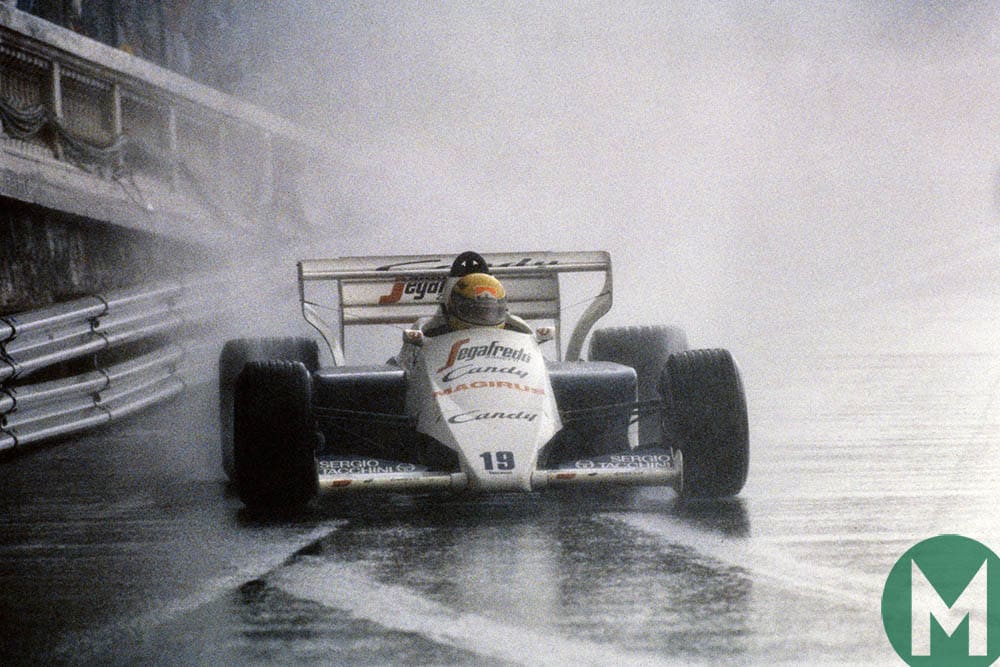
Ayrton Senna (pictured above) could well have beaten Alain Prost had the race not been stopped early
Motorsport Images
It was a few seconds before ten minutes to five on Sunday June 3rd that Jacky Ickx, as Clerk of the Course for the 1984 Monaco Grand Prix, finally gave the instruction to show the red flag and the chequered flag at the start line, thereby defusing what was quickly becoming an explosive contest between Alain Prost’s McLaren MP4/2 and the Hart-engined Toleman TG184 of new boy Ayrton Senna. Taking a personal, and reflective, view of this race rather than providing Motor Sport’s readers with only a blow-by-blow account of the proceedings, I have to say that my initial reaction was to think back 12 years to the 1972 Monaco Grand Prix which was run in similar conditions of appalling rain and spray — a race which wasn’t stopped and was finally won by Jean-Pierre Beltoise after a magnificent display of car control at the wheel of his BRM P160. One of the most accomplished wet weather “aces” of that time was out-driven by Beltoise on this rare occasion and finished second at the wheel of his Ferrari 312B2. His name, of course, was Jacky Ickx…
Memories play tricks on people, of course, but I’m bound to say that I don’t feel the weather conditions at Monaco in 1984 were significantly worse than in ’72, although whether any conclusions can be drawn from the fact that Beltoise’s winning average was 102 kph on the faster “pre-’73” circuit, as opposed to Prost’s average of 100.775 kph in this year’s event, is difficult for me to say.
One thing, of course, it is easy to be sure of. In circumstances such as those which prevailed this year at Monaco, you can be certain that some people will emerge from the event chorusing “we was robbed!”, or words to that effect. However, one must remember one crucial factor when examining these claims: Alain Prost was just about the only driver on the circuit not to make a single driving error all weekend. The Frenchman, who has already won two Grands Prix this year, qualified on pole position with a lap in 1 min 22.661 sec and simply smiled quietly when asked by the press “what problems did you have?” Such an invitation from the scribes at Monaco is invariably met with the very serious explanation “well, I would have been half a second quicker, but I was badly baulked on my second set of qualifiers”. Of course, with 27 cars frantically attempting to qualify tor 20 starting positions on this tight little circuit, for most of the time somebody is bound to be in somebody else’s way, so that is a fact of life everybody must accept. Some people seem to be better finding “holes in the traffic” than others and, although the writer definitely witnessed occasions on which certain leading runners had grounds for complaint over the behaviour of backmarkers, the moan “I got held up” is now used by many people as a stock excuse for “failing to get their act together”.
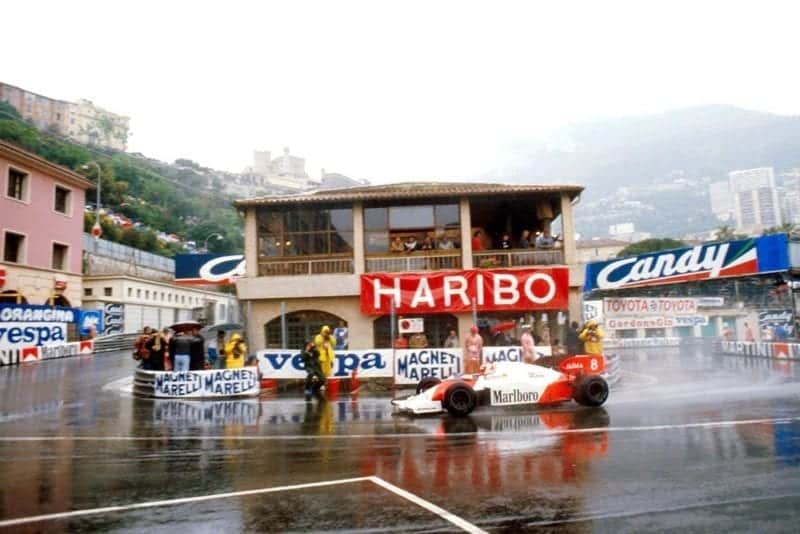
Struggling with the brakes on his McLaren, Niki Lauda spun out on lap 23
Motorsport Images
If the race had been a couple of laps longer, Prost’s brake-troubled McLaren would have been devoured by the fast-rising Toleman TG184 of Brazilian Formula 3 graduate Ayrton Senna. Last year Senna won the British Formula 3 Championship in a fashion which indicated he had a promising future. He was snapped up by the Toleman-Hart team after Derek Warwick decided he would move on to Renault, and his performance at Monaco underlined that he had a bright, racing future ahead of him.
The Toleman / Senna partnership strikes me as very well-matched. By the end of last season it was clear that Derek Warwick’s “progression curve” was running slightly ahead of the Toleman team’s and, after three loyal years’ service, Derek’s career was probably better served by moving on to an established organisation such as Renault. This doesn’t imply any criticism of Toleman, simply the fact that even Brian Hart’s brilliance in the business of producing power from the neat little 415T engine couldn’t approach the outputs of the “megabuck” engine manufacturers such as Renault, Ferrari and BMW. Toleman also had problems with its tyre suppliers, Pirelli, and was short on finance.
Now the team has paused for breath and re-grouped. The result is a promising new chassis running on Michelin tyres and hopes for increased power output from the Hart engine now that Brian is developing an electronic fuel injection system. Senna has come in as a wide-eyed, optimistic new boy and the chances are that his talent and enthusiasm will carry the team further “second time round”, so to speak, than if the situation had remained as it was in ’83. In dry qualifying at Monaco, Senna could only snatch 13th position on the grid on a 1 min 25.009 sec, but in the wet race the power deficiency didn’t matter one bit.
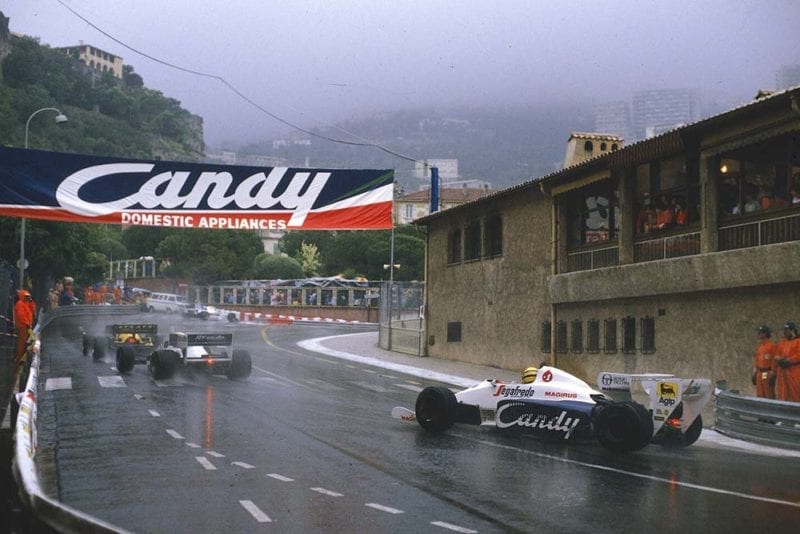
Toleman’s Senna chases down the Williams of Keke Rosberg
Motorsport Images
Senna revelled in the good handling qualities of the Toleman chassis and came bounding through the field to finish second, closing rapidly on the leader towards the end of the prematurely terminated event. But even his race was not faultless. Close behind Rosberg’s Williams FW09 under braking for the harbour-front chicane on lap 10, Senna hit the kerb very hard indeed, launching his car into the air and “stretching” a front suspension pull-rod into the bargain. Whilst he and the Toleman team had every right to feel indignant about the fact the race was stopped just when victory was within their grasp, the fact remains that Senna was lucky — or skilled — to finish. He has time on his side, however, and I believe his day will come very soon.
If third placeman Stefan Bellof made any mistake, then I didn’t see it. If one was cynical, one could say that the only mistake he made was not driving a car with a turbocharged engine, but, of course, the only reason he was having such a delightful, uninhibited time in the rain was that his Cosworth DFY-engined Tyrrell 012 proved an agile and easy-to-drive proposition in the diabolical conditions. He just scraped in onto the grid in 20th (and last) position, but drove magnificently, respecting no reputations, to finish third when the chequered flag was shown. Bellof, too, is another man with a bright future ahead of him.
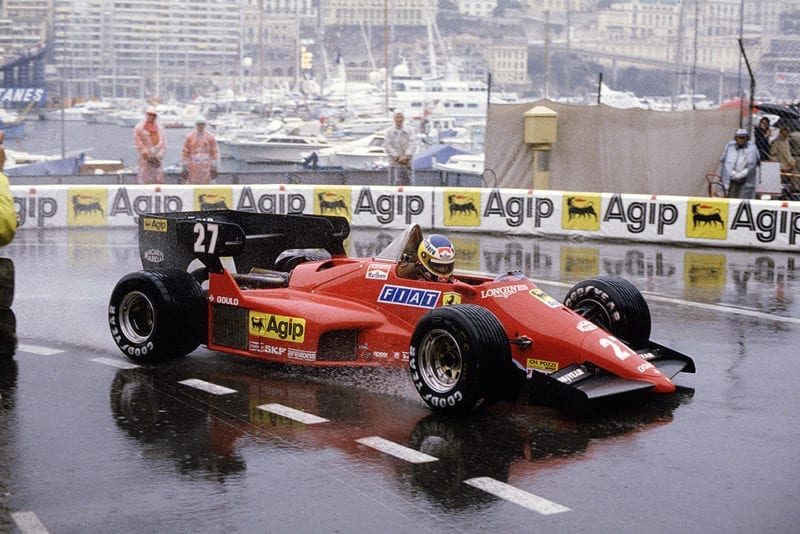
Michele Alboreto struggled in the wet conditions, spinning off and ending up a lap down
Motorsport Images
Having examined the top three finishers at Monaco, what about the losers? Well, the most spectacular failure was unquestionably that of the Renault Elf team whose RE50s ended up wrecked against each other on the first corner of the race. Despite their two qualifying sessions being hampered by minor mechanical problems, Derek Warwick and Patrick Tambay did reasonably well to qualify fifth and sixth, side-by side on the third row. At the start they both got away well and Warwick nosed into third place as they braked for Ste Devote, the slow right-hander which leads onto the hill up to Casino Square.
Unfortunately, Rene Arnoux’s Ferrari C4 was on Derek’s right and, whether by accident or design, the Italian car driven by the former Renault driver slid off the sloping kerb on the apex of the corner and propelled Warwick into the tyre barrier on the outside. To compound the disaster, Tambay’s Renault, on a wide line, plunged straight into Warwick’s machine and the two men were out on the spot, Patrick with a broken bone in his left leg.
The accident in itself was just one of those unfortunate things, but there were other aspects which held people’s attention. Warwick’s car had hit the tyre barrier relatively slowly in second gear, yet the front end of the carbon-fibre composite monocoque had “snapped off’ from driver’s knee level. Derek was clearly very shaken by this discovery and, needless to say, talk of the failure went round the paddock like wildfire. It is always very dangerous to speculate on the safety or otherwise of various means of chassis construction, because one never really knows the true nature of the impact involved, but it is fair to say that one or two rival designers raised their eyebrows in mirrored concern. In this connection it is worth mentioning that Brabham’s Gordon Murray and Williams’s Patrick Head still shy away from building pure carbon-fibre composite monocoques simply because they have yet to see the consequences of a major frontal collision on a car employing this sort of construction. On the other hand, both Lotus and Toleman, who employ Kevlar-strengthened carbon-fibre composite monocoques, have seen their cars get involved in huge accidents over the past couple of years and the tubs have barely been dented. Perhaps Renault was just unlucky with its angle of impact on this occasion or something. . .
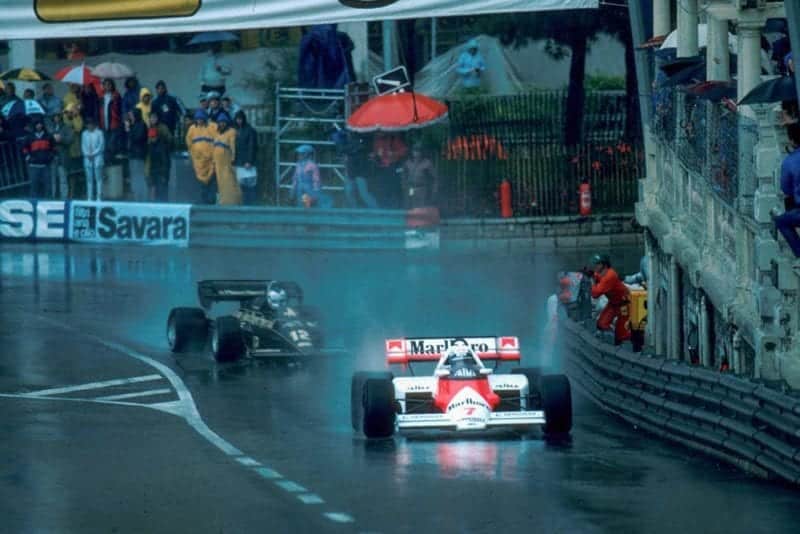
Mansell chases down Alain Prost
Motorsport Images
Apart from Prost, the only man to lead the Monaco Grand Prix was Britain’s Nigel Mansell at the wheel of his Lotus 95T-Renault. Mansell qualified brilliantly second on the grid, despite having a somewhat confused final hour timed practice when his practice car (the spare) suffered engine failure out on the circuit and he had to run back to the pits and take over his race-ready machine which had been prepared for the following day’s Grand Prix.
In common with the other Goodyear runners, Mansell’s assault on final qualifying had involved running a harder left rear tyre than usual in conjunction with three “qualifiers” on the remaining wheel rims, the idea being that one could stay out for three or four laps if one had to “abort” one’s quickest run through being baulked by a slower car. Unfortunately this tyre set-up had been fitted to the car which expired on the circuit, leaving Nigel his race car and one set of soft tyres to get the job done. It was precisely the sort of situation that often brings out the best in a competitive racing driver and it certainly did in Mansell’s case; his quickest lap of 1 min 22.752 sec was an absolute joy to behold, as well as being good enough to earn himself his best-ever grid position alongside Prost on the front row.
In the race Mansell shadowed Prost confidently, pacing himself nicely, before darting into the lead on lap 11 when the McLaren driver was outfumbled as the two leading cars came up to lap Michele Alboreto’s Ferrari C4 which had been delayed by a time-consuming spin. Mansell led across the timing line on five occasions, the last time being at the end of lap 15. Going up the hill after Ste Devote on his 16th lap, by his own admission he placed his car slightly “out of line” and got severe wheelspin on the extra-slippery painted road markings which abound all round this street circuit. The Lotus got away from him and he glanced the barrier sufficiently hard to incur damage which eliminated his car from the race. Obviously it was an enormous disappointment for both Mansell and the entire Lotus team.
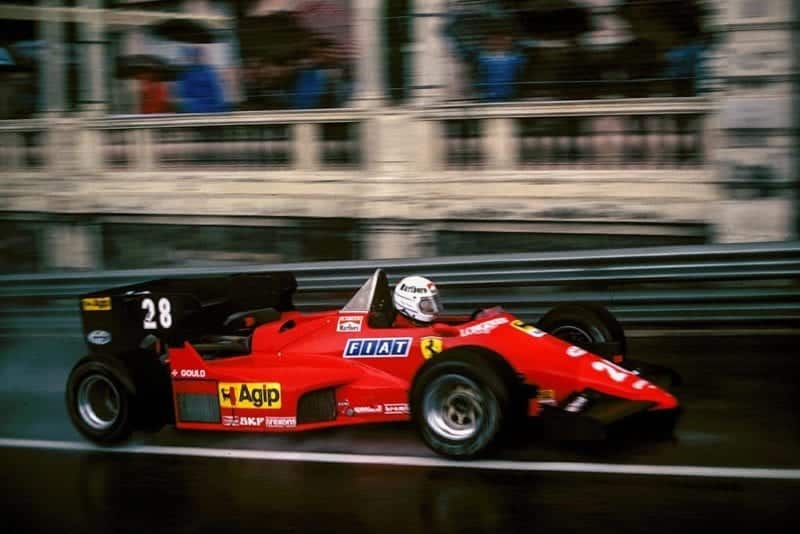
Rene Arnoux started and finished in the same position after Bellof’s disqualification
Motorsport Images
Mansell’s sheer bravery and determination cannot be questioned, but I was rather surprised to hear him remark to Murray Walker on BBC Television that evening that he thought he had “been penalised beyond reason” for a slight driving error. That, surely, is the name of the game, particularly on a day when the super-sensitive Niki Lauda spun into retirement in Casino Square after an error which he confessed was “all Lauda and nothing to do with the car”. Mansell’s determination tends to get him into situations from which his talent cannot extricate himself (viz not only Monaco, but Brazil earlier in the year as well) and I am beginning to wonder whether, after 49 Grands Prix, he has reached a performance plateau. It is a pretty open secret within the Formula 1 business that he was Lotus’s “third choice” British driver at the end of the 1983 season and he only retained his seat after Derek Warwick and John Watson declined the invitation. On the other hand, he was number one on the Williams list at one time to replace Keke Rosberg had the Finn declined to sign up with the Didcot team in ’84. It’s not likely to be a popular opinion, but I honestly feel that Mansell may have more to give in another environment: we have never seen him in anything else but a Lotus, all too frequently being obliged to play “second fiddle” to Elio de Angelis. I don’t feel that Mansell will ever be World Champion, but there is no reason why his talent shouldn’t earn him a Grand Prix victory or two. However, I doubt either will come behind the wheel of a Lotus.
Two teams managed to finish two cars at Monaco — Ferrari and Williams. The two Italian machines qualified on the second row of the grid and Rene Arnoux coped well, if unobtrusively, with a waterlogged engine to bring his 126C4 home in fourth place. Alboreto spun and eventually came home seventh. Keke Rosberg, plagued by understeer in his Williams-Honda FW09, qualified a lowly tenth but pulled through to finish fifth at the finish, indignant that the race was prematurely stopped. “I was concentrating on driving smoothly and making no mistakes,” he admitted, “and I felt that if I was fifth at the end of an hour, I would be well placed at the end of two hours. Unfortunately the race finished at the end of the first hour” Rosberg, who made his name when he won the 1978 International Trophy at the wheel of a Theodore in similarly streaming conditions at Silverstone, felt that the Monaco conditions were no worse “although visibility was certainly bad”. His team-mate Jacques Laffite was the final finisher in ninth position, the Frenchman having made a pit stop for fresh tyres after suspecting his FW09 was suffering from a puncture.

Mansell backed his Lotus into the wall on lap 16, damaging the Lotus and ending his race
Motorsport Images
Elio de Angelis’s Lotus 95T cruised home sixth, having been delayed in the first corner fracas with the Renaults, while Piercarlo Ghinzani’s Osella struggled home eighth between Alboreto and Laffite. Neither Ligier nor Brabham made it to the chequered flag.
On a positive note it was nice to be able to record that both Manfred Winkelhock and Martin Brundle survived unscathed from particularly violent practice accidents at the wheel of ATS and Tyrrell respectively, although the young Englishman failed to qualify his Cosworth V8-engined car. With Bellof only scraping onto the back of the grid, Monaco scotched the notion that an agile non-turbo might be a worthwhile proposition on this street circuit, even in the dry. But the fact of the matter is that there is no substitute for sheer power these days in F1 qualifying and that’s an end to the matter. Marc Surer can at least console himself with the fact that, although he opted for a Cosworth-engined Arrows A6 in the vain hope of qualifying, his team-mate Thierry Boutsen couldn’t get into the race in the BMW turbo-engined Arrows A7. Something which perhaps proves that turbocharged engines don’t offer instant competitiveness: they have just raised the overall performance “scale” onto a higher level. The good teams are still good, the indifferent still indifferent and the remainder still somewhere in between. .
Of course, there is no real reason why 26 cars should not start at Monaco— as they do at Detroit and Montreal and will do at Dallas. If we can cope with 27 of them all scrambling to qualify during a frantic final hour of qualifying, then there is no earthly point in restricting the grid to 20 runners. Particularly, as was emphasised in this year’s race, when the field seldom completes the opening lap of the Monaco Grand Prix with all the competitors still running.
A.H.
RESULTS
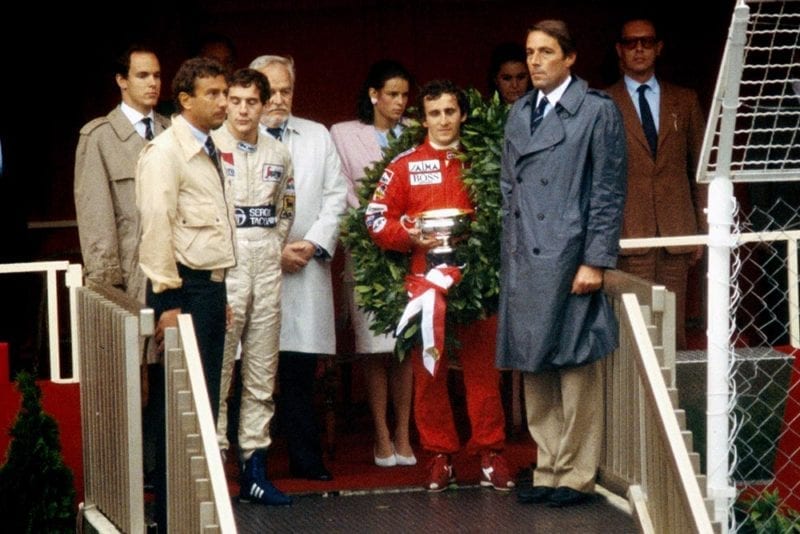
Prost holds the winner’s trophy whilst Senna looks less than amused
Motorsport Images
Monaco Grand Prix – Formula One — Race stopped at 31 laps — Monte Carlo 3.312 kilometres per lap — 1 0 2 kilometres — Torrential rain
1st : Alain Prost …………………..(McLaren MP4/2-2) ………………..1 hr 01 min 07.740 sec — 100.775 sec
2nd : Ayrton Senna ……………….(Toleman TG184/T/2) ……………….1 hr 01 min 15.186 sec
3rd : Stefan Bellof ………………..(Tyrrell 012/4) ………………………….1 hr 01 min 28.881 sec
4th : Rene Arnoux ……………….(Ferrari 126C4/074)………………….. 1 hr 01 min 36.817 sec
5th : Keijo Rosberg………………. (Williams FW09/5) ……………………1 hr. 01 min 42.986 sec
6th : Elio de Angelis ………………(Lotus 95T/3) …………………………..1 hr 01 min 52.179 sec
7th : Michele Alboreto ………….(Ferrari 126C4/075) ………………….1 lap behind
8th : Piercarlo Ghinzani …………(Osella FA/1F-2) ……………………….1 lap behind
9th : Jacques Laffite ……………..(Williams FW09/3) ……………………1 lap behind .
10th : Riccardo Patrese …………(Alfa Romeo 184T/02) ………………..retired on lap 25 — engine died
11th : Niki Lauda ………………….(McLaren MP4/2-1) …………………retired on lap 24 — spun and stalled
12th : Manfred Winkelhock ……(ATS D7/1) ……………………………….retired on lap 23 — accident
13th : Nigel Mansell ………………(Lotus 95T/2) ……………………………retired on lap 16 — accident
14th : Nelson Piquet ……………..(Brabham BT53/5) …………………retired on lap 15 –spun and stalled
15th : Francois Hesnault …………(Ligier JS23/02) ……………………retired on lap 13 — engine died
16th : CorradoFabi ………………..(Brabham BT53/2) ……………….retired on lap 10 –spun and stalled
17th : Johnny Cecotto …………….(Toleman TG184T/3) …………..retired on lap 2 — engined died
18th : Andrea de Cesaris …………(Ligier JS23/04) …………………..retired on lap 1 –collision damage
19th : Derek Warwick …………….(Renault RE50/06) ……………….retired on lap 1 –accident
20th : Patrick Tambay …………….(Renault RE50/05) ………………retired on lap 1 — accident
Fastest Lap: Ayrton Senna (Toleman TG184 T’2) on lap 24 in 1 min 54.334 sec — 104.283 kph
20 starters — 9 finishers
